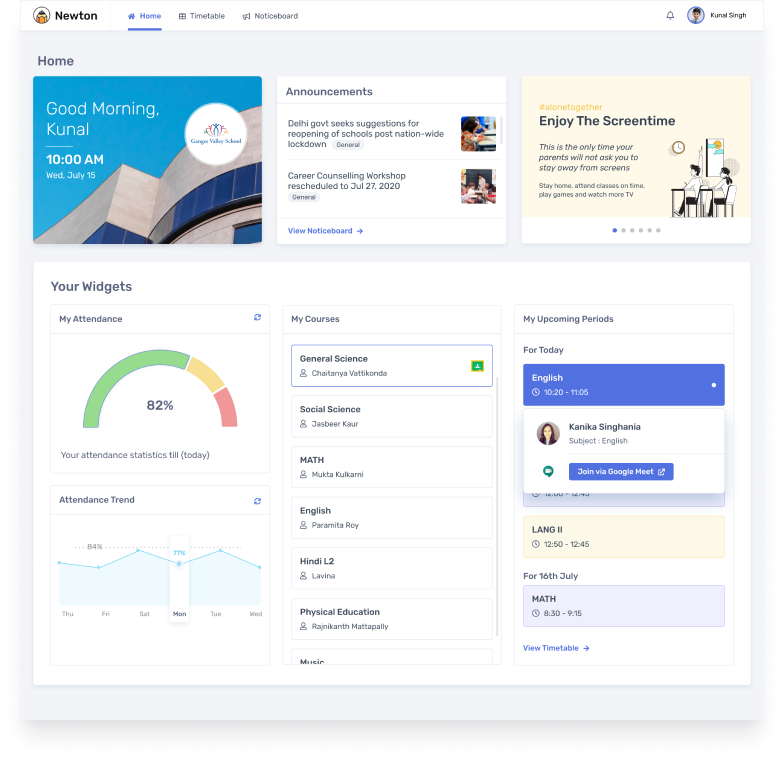classbloom
TL;DR : When the pandemic forced schools online overnight, everything changed—especially for teachers and parents. Classes were scattered across messages, apps, and devices. We had 90 days to bring it all together. As founding design lead, I helped launch a unified web and mobile platform that reached over 20,000 students. Attendance rose by 21%, and we secured our first paying clients.
context
Setting the stage: why this product needed to exist and what we aimed to achieve.
It's early 2020. Most schools weren’t equipped for remote learning. Teachers relied on WhatsApp to send daily Zoom links. Parents, adjusting to remote work themselves, had to coordinate class times while managing their own schedules.
What we set out to do:
- Make online classes simple to join
- Digitize scheduling, attendance, and communication
- Launch both mobile and desktop platforms in under 90 days
problems
Summarizing the pain points that shaped the design direction—across teachers, students, and parents.
Manual scheduling – Teachers shared class links manually, class by class.
Parent stress – Parents had to manage school coordination alongside their own remote jobs, often leading to frustration and low trust in the system.
Cumbersome attendance – Up to 10 minutes of class time was spent marking attendance.
problems
Hey there, this is the default text for a new paragraph. Feel free to edit this paragraph by double clicking on this text to bring up the editor.





Hey there, this is the default text for a new paragraph. Feel free to edit this paragraph.

Hey there, this is the default text for a new paragraph. Feel free to edit this paragraph.

Hey there, this is the default text for a new paragraph. Feel free to edit this paragraph.
research approach
How we uncovered root problems and validated early ideas using a lean, mixed-method approach.
To understand what users truly needed, we spoke with teachers, students, parents, and school administrators. Our research focused on three areas:
Formative (80%) – Interviews with 2–3 people from each group revealed major friction points:
- Teachers relied on WhatsApp for sharing schedules
- Parents struggled with daily coordination
- Manual processes took up valuable teaching time. Of a class of 50 minutes, more than 10% of the time was spent in marking attendance.
- Students had trouble staying engaged or getting online consistently
Summative (15%) – We tested wireframes with teachers and admins to refine navigation and simplify core workflows.
Sensorial (5%) – After launch, analytics showed it took students over 90 seconds to join a class. By moving join links to the dashboard, we cut that time to 53 seconds.
process & strategy
The strategic choices that helped us deliver fast without compromising user value.
I led a team of 3 designers and stayed tightly aligned with PMs and developers throughout.
With a tight 90-day launch timeline, we kept our approach lean:
- Brought engineers in early to identify blockers and reduce rework.
- Defined 95% of edge cases during the wireframe phase.
- Used ANT Design components for consistency and speed.

technical constraints
Smart design decisions to work around platform limitations.
We didn’t control the video infrastructure, so we integrated with Google Classroom. This gave us access to Meet APIs—but with limits. We couldn’t alter the video experience, only layer value on top.
As design lead, I focused on what we could control:
- Google IDs removed onboarding friction
- Join/drop data powered instant attendance reports
- Network strength helped teachers flag connectivity issues with families
key solutions
The experience we delivered—and how each solution addressed real user needs.
We focused on simplifying core user flows across all roles. Teachers got a dashboard to manage schedules and attendance in one place. Parents received timely alerts and visibility into class schedules. Students benefited from a fast, low-friction dashboard that worked well across devices. Under the hood, attendance was automated and resilience features ensured consistent access—even under poor network conditions.

Hey there, this is the default text for a new paragraph. Feel free to edit this paragraph by double clicking on this text to bring up the editor.

Hey there, this is the default text for a new paragraph. Feel free to edit this paragraph by double clicking on this text to bring up the editor.

Hey there, this is the default text for a new paragraph. Feel free to edit this paragraph by double clicking on this text to bring up the editor.
where we made a difference
Launched mobile and web apps in under 90 days, scaling to 50,000+ daily users. The strong adoption helped us secure paying clients and extend our investor runway by two years.
50,000
Daily active users
22%
Increased student attendance
10min
Time saved by teachers per a class of 50 min
59%
Faster class joining times for teachers and students.

" The platform made virtual learning easier—and the attendance feature actually motivated me to show up every day."
Jonathan Danielsen
Grade 10 Student

Selected Works
